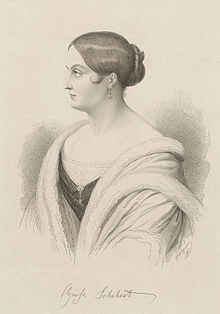Agnese Schebest
Agnese Schebest , born Agnese Šebesta , also Agnese Schebesta (born February 10, 1813 in Vienna , † December 22, 1869 in Stuttgart ) was an Austrian opera singer ( mezzo-soprano ). She lived as a singing teacher in Munich and Stuttgart.
Life
The daughter of a Czech mine leader in the Austrian army moved with her parents to Prague as a child because her father changed her job . Her father died as a result of an injury when the fortifications of Alessandria were blown up in 1816.
She lived with her mother in Theresienstadt , where she attracted attention as a child at church concerts. At the age of eleven she received free singing lessons from Kammersänger Johann Aloys Miksch and acting lessons from the actress Friederike Werdy in Dresden . She sang early as a chorus and Comprimaria at the Dresden Court Opera .
Schebest made her operatic debut in 1830 as Benjamin in Étienne-Nicolas Méhuls Joseph and his brothers at the Dresden court stage. She then got a job there, which enabled her to provide for her family financially. Other roles were Leonore in Fidelio , Rebecca in Heinrich Marschner's Der Templer und die Jüdin , Sesto in La clemenza di Tito and Alice in Giacomo Meyerbeer's Robert le diable . Wilhelmine Schröder-Devrient also worked in Dresden at the time, and she was deeply impressed by her.
After two years, she canceled the Dresden contract, which also obliged her to act, as she feared that the voice training could suffer from the speaking roles. After successful guest performances in Berlin and Leipzig , she accepted an invitation to the stage in Pest in the spring of 1832 , where she was under contract until 1836. There she had success as Agathe in Der Freischütz , Emmeline in Joseph Weigl's Die Schweizer Familie , Zerlina in Don Giovanni , Desdemona in Rossini's Otello , in the title role in Cherubini's Medea and especially as Romeo in I Capuleti ed i Montecchi by Vincenzo Bellini .
In 1834 and 1835 she made guest tours to Vienna, Dresden and Graz . After the end of her engagement in Pest, she appeared at leading German opera houses from 1836 to 1841. At that time she lived in Nuremberg . After a stay in Paris , she toured Italy in 1841, performing in Trieste and Venice . Then she came to Weimar , Schwerin , Warsaw , Lemberg , Munich and finally in June 1842 to Karlsruhe . She ended her career because she married the theologian and biographer David Friedrich Strauss . The marriage, which resulted in two children, was unhappy and was divorced after a few years.
Works
- From the life of an artist Stuttgart: Ebner & Seubert, 1857 ( Google digitized version )
- Speech and giving. Studies on Oral Lecture and Plastic Expression Leipzig: Abel, 1861
literature
- Heinrich Ferdinand Mannstein : Memories of the electoral and royal court music in Dresden in the 18th and 19th centuries: According to secret papers and communications. Contains : Life pictures of Joh. Mieksch and his students: Alphonso Zesi, Bergmann , Schröder-Devrient , Agnes Schebest, Naumann , Carl Maria v. Weber , Morlacchi , Benelli etc. Heinrich Mattes, Leipzig 1863 MDZ Reader .
- Constantin von Wurzbach : Schebest, Agnese . In: Biographisches Lexikon des Kaiserthums Oesterreich . 29th part. Kaiserlich-Königliche Hof- und Staatsdruckerei, Vienna 1875, pp. 140–144 ( digitized version ).
- Heinrich Welti: Schebest, Agnese . In: Allgemeine Deutsche Biographie (ADB). Volume 30, Duncker & Humblot, Leipzig 1890, pp. 651-653.
- C. Höslinger: Schebest Agnese. In: Austrian Biographical Lexicon 1815–1950 (ÖBL). Volume 10, Verlag der Österreichischen Akademie der Wissenschaften, Vienna 1994, ISBN 3-7001-2186-5 , p. 55 f. (Direct links on p. 55 , p. 56 ).
- Anton Schott u. Maximilian Hörberg (Ed.): Hie Welf! Hie Waibling! - Controversial issues in the field of song (revised new edition of the 1st edition: Berlin 1904), Verlag Maximilian Hörberg, Munich 2008. ISBN 978-3-00-022594-9 .
Web links
Individual evidence
- ↑ Birth and death dates according to Karl-Josef Kutsch , Leo Riemens : Großes Sängerlexikon , 4th edition, Munich 2003 and Große Bayerische Biographische Enzyklopädie, Munich 2005. The biography , which was discontinued in 2009 , on the other hand, mentions February 15, 1813 as the date of birth and February 22 January 1870 as the date of death.
- ↑ Alfonso Zesi (May 17, 1799 in Milan - 1861 in Milan). Bass singer in Dresden, among others.
| personal data | |
|---|---|
| SURNAME | Schebest, Agnese |
| ALTERNATIVE NAMES | Šebesta, Agnese (maiden name); Schebesta, Agnese |
| BRIEF DESCRIPTION | Austrian opera singer (mezzo-soprano) |
| DATE OF BIRTH | February 10, 1813 |
| PLACE OF BIRTH | Vienna |
| DATE OF DEATH | December 22, 1869 |
| Place of death | Stuttgart |
